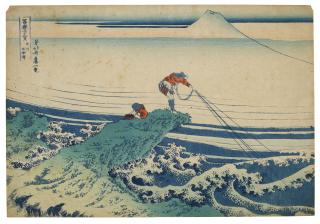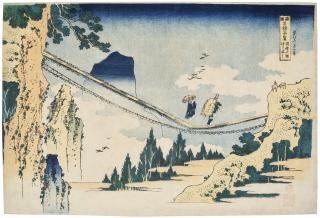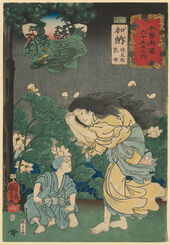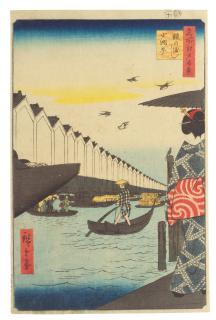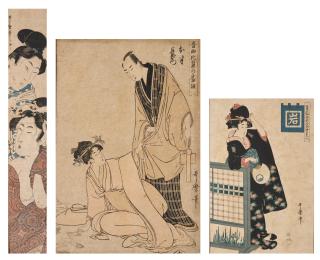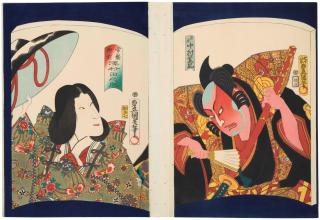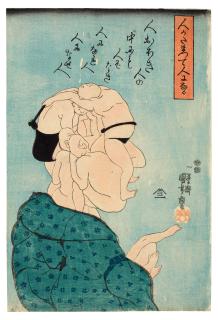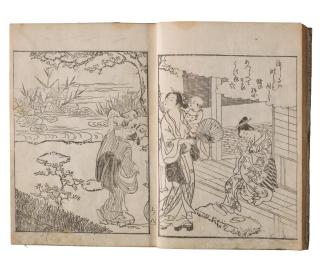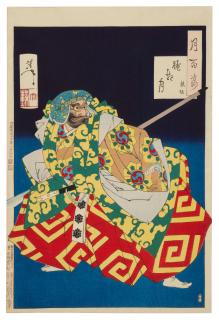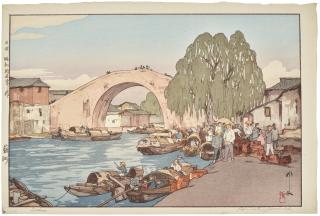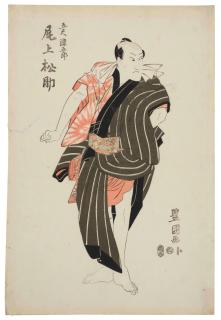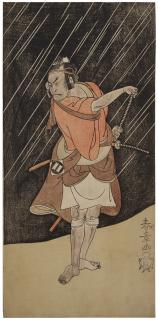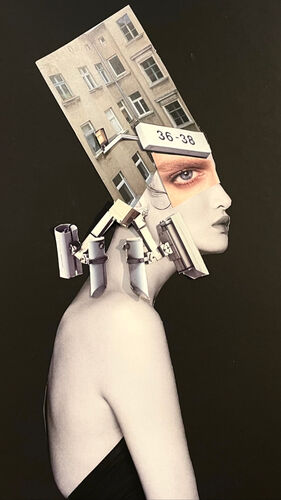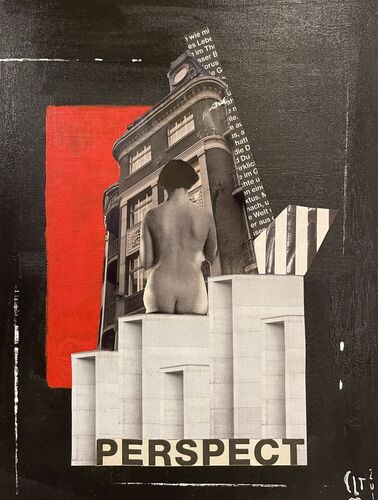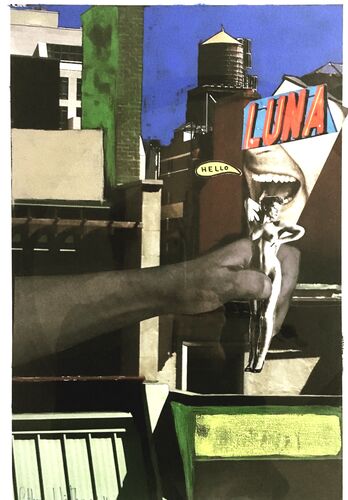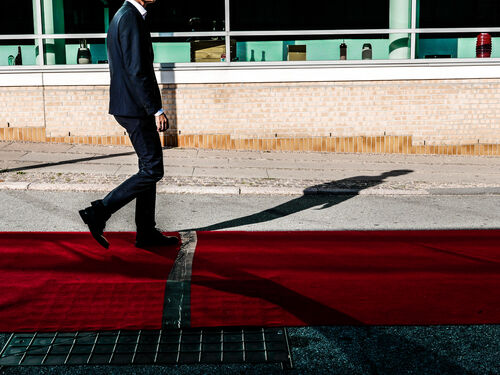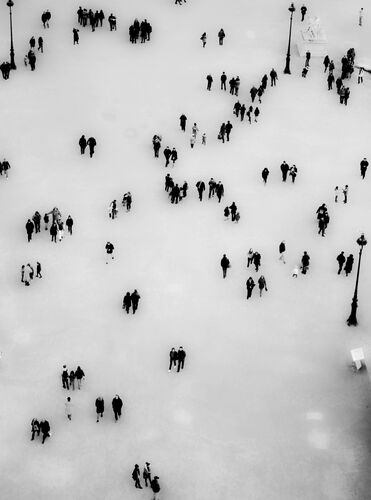Katsushika Hokusai 1760 - 1849
The artist Katsushika Hokusai
- Considered Japan's most famous artist and an important representative of the ukiyo-e genre.
- His art contributed to Japonism in Europe and inspired Impressionism as well as Art Nouveau.
- The colour woodcut »The Great Wave off Kanagawa« (1830) is considered his best-known work.
Katsushika Hokusai was an influential Japanese painter known for his ukiyo-e paintings and prints. His series of woodblock prints called 36 Views of Mount Fuji (1828-1833) is considered his most famous work, with The Great Wave off Kanagawa (1830) from the series being the best known by far. He also laid the foundation for today's manga comics with his Hokusai manga sketchbooks (1814-1815).
In his drawings and prints, Hokusai mainly depicted images of nature and landscapes, portraits, people such as samurai, sumo wrestlers or women, as well as erotic illustrations. In later works he concentrated mainly on classical Japanese subjects and objects.
His art is influenced by Chinese and Dutch landscape painting as well as by the traditional Japanese Kanō school. His paintings and woodblock prints had a profound influence on painters such as Claude Monet, Édouard Manet, Egon Schiele, Gustav Klimt, Paul Gauguin and Vincent van Gogh along with the emergence of Japonism in Europe. The latter, in turn, was considered an inspiration for art historical periods such as Impressionism and Art Nouveau - especially for Art Nouveau graphics.
Probably born on 30 or 31 October 1760 in present-day Tokyo, Katsushika Hokusai began painting at a young age and entered a block carving apprenticeship at the age of 15. At the age of 18 he was accepted into the studio of the painter and printmaker Katsukawa Shunsho and gave himself the artist's name Katsukawa Shunro. Hokusai travelled extensively and gained experience from various teachers and schools. In the course of his life he adopted more than 30 different artist names, with art from the different periods of his life under each name. With Shunsho's death in 1793, Hokusai's work changed and took on the characteristic style for which he is known today. Five years later, he took in his own first students to teach them the art of drawing and woodblock printing. From then on he produced his works under his now world-famous name Katsushika Hokusai.
He died in Tokyo on 10 May 1849 and reportedly left behind 30,000 pieces of work, including paintings, sketches, woodcuts, silk paintings and illustrated books. At the end of 2016, the Sumida Hokusai Museum was opened in Tokyo, which is dedicated to the artist. The Sumida Hokusai Museum, like the Metropolitan Museum of Art in New York and the Hermitage Museum in St. Petersburg, has collections of Hokusai's art.
Der Künstler Katsushika Hokusai
- Gilt als berühmtester Künstler Japans und als ein bedeutender Vertreter des Ukiyo-e-Genres.
- Seine Kunst trug zum Japonismus in Europa bei, inspirierte Impressionismus und Jugendstil.
- Der Farbholzschnitt »Die große Welle vor Kanagawa« (1830) gilt als sein bekanntestes Werk.
Katsushika Hokusai war ein einflussreicher japanischer Maler und bekannt für seine Ukiyo-e-Gemälde und -Drucke. Die Serie seiner Farbholzschnitte mit Namen 36 Ansichten des Berges Fuji (1828-1833) gilt als seine berühmteste Arbeit, wobei das Werk Die große Welle von Kanagawa (1830) aus der Reihe mit Abstand den höchsten Bekanntheitsgrad hat. Zudem legte er mit seinen Hokusai-Manga Skizzenbüchern (1814-1815) den Grundstein für heutige Manga-Comics.
Hokusai bildete auf seinen Zeichnungen und Drucken vornehmlich Natur- und Landschaftsbilder, Porträts, Personen wie Samurai, Sumoringer oder Frauen sowie erotische Illustrationen ab. In späteren Arbeiten konzentrierte er sich hauptsächlich auf klassische japanische Themen und Objekte.
Seine Kunst ist von chinesischer und niederländischer Landschaftsmalerei sowie von der traditionellen japanischen Kanō-Schule geprägt. Seine Gemälde und Farbholzschnitte hatten einen profunden Einfluss auf Maler wie Claude Monet, Édouard Manet, Egon Schiele, Gustav Klimt, Paul Gauguin und Vincent van Gogh und die Entstehung des Japonismus in Europa. Dieser wiederum galt als Inspiration für kunstgeschichtliche Epochen wie den Impressionismus und den Jugendstil – insbesondere für die Jugendstil-Grafik.
Vermutlich am 30. oder 31.10.1760 im heutigen Tokio geboren, begann Katsushika Hokusai das Malen bereits mit jungen Jahren und begab sich mit 15 Jahren in eine Blockschnitzerlehre. Mit 18 Jahren wurde er in das Atelier des Malers und mit Druckgrafik arbeitenden Künstlers Katsukawa Shunsho aufgenommen und gab sich den Künstlernamen Katsukawa Shunro. Hokusai unternahm viele Reisen und sammelte Erfahrungen bei verschiedenen Lehrern und Schulen. Im Laufe seines Lebens nahm er mehr als 30 verschiedene Künstlernamen an, unter jedem Namen findet sich Kunst aus den verschiedenen Perioden seines Lebens. Mit dem Tod Shunshos im Jahre 1793 änderten sich Hokusais Arbeiten und nahmen den charakteristischen Stil an, für den er heute bekannt ist. Fünf Jahre später nahm er seine ersten eigenen Schüler auf, um sie in der Zeichenkunst und der Kunst des Holzschnittes zu unterrichten. Von da an fertigte er seine Arbeiten unter seinem heute weltberühmten Namen Katsushika Hokusai.
Er starb am 10.05.1849 in Tokio und hinterließ Angaben zufolge 30.000 Werke, darunter Gemälde, Skizzen, Holzschnitte, Seidenmalereien und illustrierte Bücher. Ende 2016 wurde in Tokio das Sumida Hokusai Museum eröffnet, welches dem Künstler gewidmet ist. Wie u. a. im Metropolitan Museum of Art in New York und im Hermitage Museum in St. Petersburg, sind auch im Sumida Hokusai Museum Sammlungen Hokusais zu finden.
Katsushika Hokusai in a nutshell
Kanagawa oki nami ura (In the Well of the Great Wave off Kanagawa) is a color woodblock print by Japanese artist Katsushika Hokusai. He created it in 1831 when he was about 70 years old. The Great Wave is the first and most famous print in a series of 36 views of Mount Fuji (Fugaku sanjūrokkei) made between 1830 and 1836. Hokusai had originally planned 100 prints, but the publisher reduced the number, not believing it would be successful. The surprising success allowed Hokusai to add ten more prints, making the series 46.
The Great Wave measures 25x37 cm and exists in an estimated 8,000 original prints, some of which vary in color and detail due to wear from the printing process. Hokusai depicts the threat to people in boats from the forces of nature against the backdrop of Mount Fuji, a volcano and the highest mountain in Japan. The work became famous in Europe in the 19th century and is considered the catalyst for the Japan trend and a major influence on Impressionism. In today's pop culture representations, only the wave is often shown, and the boats and Mount Fuji are usually not the content of the image.
The 1831 woodblock print Kanagawa oki nami ura (In the Well of the Great Wave off Kanagawa) is Hokusai's most famous work and one of the most famous Japanese prints of all time. For a long time, collectors benefited from quite low estimates, but the supply was always overflowing and the selling price was much higher. In the last few decades there has been a rapid increase in prices, which is unusual for a woodblock print. In 2000, Christie's auctioned a copy for just over $28,000 (with an estimate of up to $6,000). Then in 2023, an edition sold for $2.7 million, with an estimate of up to $700,000.
Hokusai was born in Edo, now Tokyo, in late October 1760 and died there on May 10, 1849. He lived to be 88 years old and is known for woodblock prints and ukiyo-e paintings, which literally means »picture of the transient world«. They are comparable to European vanitas paintings, which remind us of the benefits of joy and pleasure in the face of short human life.
Probably the best known work after The Great Wave is South Wind, Clear Sky, also called Red Fuji. It is from the same series of paintings of Mount Fuji from the 1830s and shows the volcano tinted red by the sunrise, a well-known natural spectacle in Japan. This print is more appreciated in Japan than The Great Wave, which is considered to be the most outstanding Japanese print abroad.
The most famous shunga, or erotic prints, by Hokusai is The Dream of the Fisherman's Wife (Tako to Ama) from 1814, a woodblock print that appeared in Hokusai's series Kinoe no Komatsu. It depicts the sexual act of an ama, a Japanese female apnoea diver, with two octopuses. The image is a forerunner of the tentacle eroticism that became popular in Europe in the 20th century (Picasso made a drawing of it in 1903) and is particularly popular in Japanese manga.
Hokusai's works are in collections of renowned museums worldwide. These include the Tokyo National Museum, the British Museum in London, the Museum of Asian Art in Berlin, the National Gallery of Victoria in Melbourne, the Metropolitan Museum of Art in New York, and the Museum of Fine Arts in Boston.
Häufige Fragen zu Katsushika Hokusai
Kanagawa oki nami ura (In the well of the great wave off Kanagawa) ist ein Farbholzschnitt des japanischen Künstlers Katsushika Hokusai. Er schuf ihn 1831 im Alter von etwa 70 Jahren. Die große Welle ist das erste und berühmteste Blatt einer Serie von 36 Ansichten des Berges Fuji (Fugaku sanjūrokkei), die zwischen 1830 und 1836 entstand. Ursprünglich plante Hokusai 100 Ansichten, aber der Verleger reduzierte die Anzahl, da er nicht an den Erfolg glaubte. Der überraschende Erfolg ermöglichte es Hokusai, zehn weitere Blätter anzufügen, so dass die Serie 46 Blätter umfasst.
Die große Welle misst 25x37 cm und existiert in schätzungsweise 8.000 Originalabzügen, die sich aufgrund der Abnutzung im Druckprozess teilweise in der Farbgebung und in der Ausarbeitung der Details unterscheiden. Hokusai zeigt die Bedrohung der Menschen in den Booten durch die Naturgewalten vor dem Berg Fuji, einem Vulkan und dem höchsten Berg Japans. Das Werk wurde im 19. Jahrhundert in Europa bekannt und gilt als Auslöser des Japan-Trends und als entscheidender Einfluss des Impressionismus. In der heutigen popkulturellen Darstellung wird meist nur die Welle gezeigt, die Boote und der Berg Fuji sind oft nicht Bildinhalt.
Der Holzschnitt Kanagawa oki nami ura (In the well of the great wave off Kanagawa) von 1831 ist das berühmteste Werk von Hokusai und eines der berühmtesten japanischen Kunstwerke überhaupt. Lange Zeit profitierten Sammler von recht geringen Schätzpreisen, die Angebote überschlugen sich jedoch immer und der Verkaufspreis lag deutlich höher. In den letzten Jahrzehnten ist eine rasante Preissteigerung zu beobachten, die gerade für einen Holzschnitt außergewöhnlich ist. Im Jahr 2000 versteigerte Christie’s ein Exemplar für etwas über 28.000 US-Dollar (bei einem Schätzpreis bis 6.000 US-Dollar). Im Jahr 2023 dann erzielte eine Ausgabe den Preis von 2,7 Millionen US-Dollar, bei einem Schätzpreis bis 700.000 US-Dollar.
Hokusai wurde Ende Oktober 1760 in Edo, dem heutigen Tokio, geboren und starb am 10. Mai 1849 dort. Er wurde 88 Jahre alt und ist bekannt für Farbholzschnitte und ukiyo-e-Malerei, was wörtlich übersetzt »Bild der vergänglichen Welt« bedeutet. Sie sind vergleichbar mit europäischen Vanitas-Bildern, die im Angesicht des kurzen menschlichen Lebens an die Vorzüge von Freude und Vergnügen erinnern.
Das nach der großen Welle wohl bekannteste Werk ist South Wind, Clear Sky, auch Red Fuji betitelt. Es stammt aus derselben Bildserie mit Ansichten des Berges Fuji aus den 1830ern und zeigt den Vulkan rot gefärbt vom Sonnenaufgang, einem bekannten Naturschauspiel in Japan. Dort wird dieser Druck mehr geschätzt als die große Welle, die eher im Ausland als hervorragendster japanischer Farbholzschnitt gilt.
Das bekannteste shunga, erotische Abbildungen, von Hokusai ist The Dream oft he Fisherman’s Wife (Tako to Ama, wörtlich: Oktopoden und die Muscheltaucherin) von 1814. Es ist ein Holzschnitt, der in Hokusais Bildserie Kinoe no Komatsu erschien. Es zeigt den sexuellen Akt einer Ama, einer japanischen Apnoetaucherin, mit zwei Oktopoden. Das Bild ist ein Vorläufer der Tentakelerotik, die seit dem 20. Jahrhundert auch in Europa bekannt (Picasso fertigte 1903 eine Zeichnung dazu an) und vor allem im japanischen Manga populär ist.
Hokusais Arbeiten befinden sich weltweit in Sammlungen namhafter Museen. Dazu zählen das Tokyo National Museum, das British Museum in London, das Museum für Asiatische Kunst in Berlin, die National Gallery of Victoria in Melbourne, das Metropolitan Museum of Art in New York und das Museum of Fine Arts in Boston.

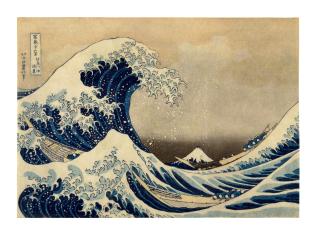
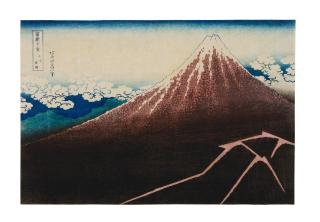

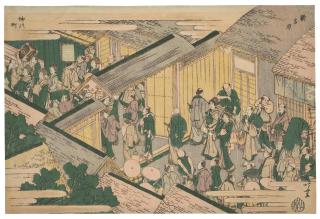
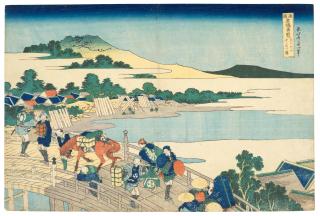
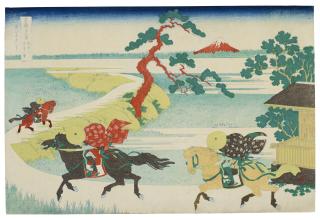
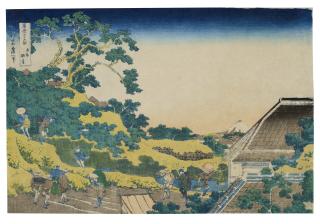
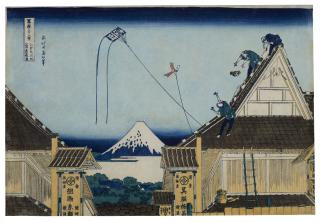
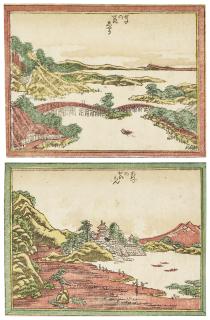
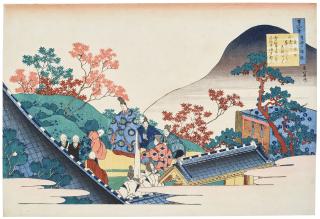
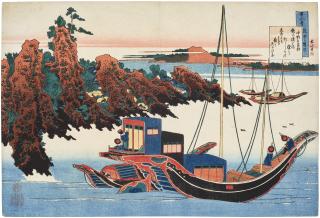
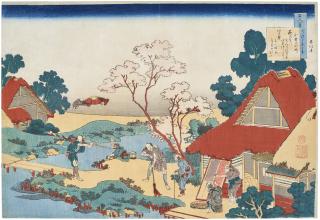





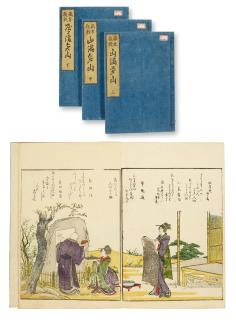
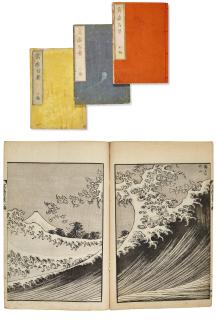
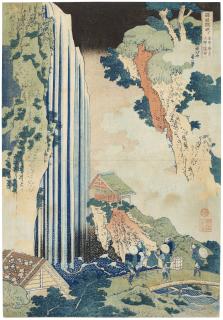
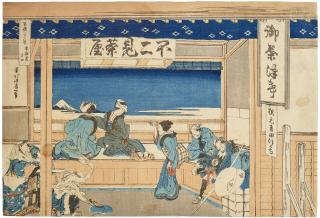
![Katsushika Hokusai - Kanagawa oki nami ura (Under the well of the Great Wave off Kanagawa) [“Great Wave”]](/images/katsushika-hokusai_kanagawa-oki-nami-ura-under-the-well-of-the-great-wave-off-kanagawa-great-wave_AID1203333_320x320.jpg)
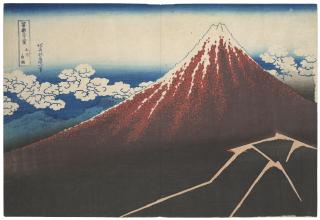
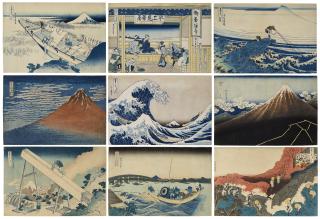
![Katsushika Hokusai - Gaifu kaisei (Fine wind, clear weather) [“Red Fuji”]](/images/katsushika-hokusai_gaifu-kaisei-fine-wind-clear-weather-red-fuji_AID1208746_320x320.jpg)
